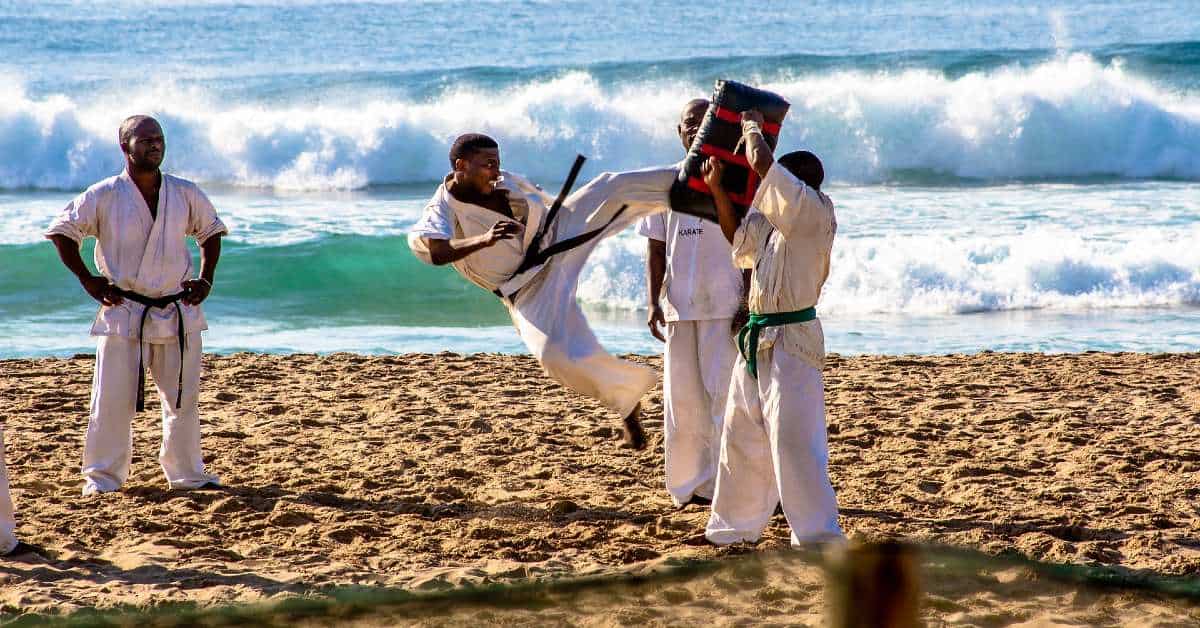The World Karate Federation (WKF) has employed some rules guiding the types of techniques you need to apply on your opponent, more so the kicking techniques. It has caught you into a state of a mix-up on where on the opponent should the kick land on to earn you better points since every destination has its own awarding. You may need to work on your kicks. The best way to do that is by first knowing where you want your foot to be hitting on. So, can you kick in the face in Karate?
A karate kick to the face is legal and more universal than a low-kick that is even banned in karate competitions, in case it appears to be too low. Kick to the face earns you the highest number of points, three, regarded as “ippon”.
Even though allowed, it shouldn’t be too solid to lead to a knockout or even cause injuries to your opponent in most sport karate. You have to control the kicking leg and only do “Jordan Geri” when you are fit enough to do so. “Jordan Geri” is a kick delivered to the upper body. Jordan is a karate term for the neck, the face, and the head while “Geri” means a kick.
In case you’re intervening about a good solid kick that can knock a few teeth down or get through your opponent’s throat, it’ll depend on the style of sports karate which you’re practicing. Here is a list of some famous sports karate styles with their potentialities to kick someone in the face.
Karate Styles That Allows Kicks to the Face
Shotokan Karate
This style undeniably allows kicks to the face. However, it is soft contact that any strike that seems to be too hard will result in a penance. In case the harm caused is so pronounced, it’ll result in direct disqualification.
Kyokushin Karate
This style allows kicks to the face, even though it doesn’t authorize punches. Kyokushin Karate not only permits face kicking, but it pulls it to a whole distinct rank wherein you don’t gain a point with any technique, not even a face kick unless it causes the opponent to get dismantled. They then have around fifteen seconds to stand up. I’d remark face kicking is greatly encouraged if not compelled.
You can read more about Kyokushin Karate here.
American Kenpo Karate
Based on the organization, competitions can span from semi-contact to soft contact. However, the rules are kindred to Kyokushin karate rules, except that you have to touch if you need to score and not knock the opponent down. Face kicks are still legitimate.
Taikenkai Karate
This style of sport karate is also full contact, and it also authorizes face kicking. There is a snatch, however. The participants put on face masks and headgears. So while you can boot someone in the face, it’ll be badly strenuous to break a nose or strike a few teeth out of their jaws.
There are other various famous styles of sport karate like Shito Ryu, Goju Ryu, and others, but you can back on all of them to tolerate face kicks. At this moment, you have the roll of the most famous styles of sport karate. You can choose for yourself which one constitutes to “Real Karate.”
From my own perception, all of them demand proficiency in their way, and all of them have their merits as well as their downsides. In the end, it counts on the artist and not the art itself.
If you are interested, check out our article about all karate styles and their differences.
Karate Kicks to the Head
Karate in-cooperates a variety of kicks ranging from straight to rotational with a wide range of applications in either competition or street situation. Some kicking techniques are discouraged in tournaments to avoid severe damage to your competitor. However, in the street, you can apply all sorts of dangerous techniques while defending yourself. Mostly, there are only two famous kicks that are highly encouraged to be executed to the “Jordan” level during sporting but with much control. These kicks include but are not limited to roundhouse kick and the hook kick.
Roundhouse Kick
The roundhouse kick is known as “mawashi Geri.” Maswashi Geri is an ordinary Kumite kick due to its power, speed, and capability to hit a deep variety of targets at distinct heights. It’s launched for a quick attack with the front leg or extra vigor with the rear foot. When executed correctly to the head, it translates to “ippon”- 3 points. It’s usually performed as both attacking and counter-attacking such techniques like kizami zuki, gyaku zuki, etc. after an appropriate sidestepping.
Hook kick
Hook kick is known as “ura mawashi geri.” It’s one of the most applied karate kicks that reaches the head faster, somehow difficult to block, and escape, and is easy to control. It’s usually executed after proper timing and probably grabbing your opponent’s lead guard. It also provides a quick counter to most of the attacking techniques that include and are not limited to mawashi geri, kizami zuki, gyaku zuki, or to the ura mawashi geri itself. You can also show some expertise by executing this kick while spinning the hook kick.
Now that you’re informed, you can organize and restructure your training well to build on the specific techniques depending on the karate style that you practice. You should also not forget its protection role and assume such kicks like Yoko geri, Mikazuki geri, kakato geri, Mae tobi geri, Tobi yoko geri kekomi, hiza geri, and stomping kicks. As well as all dangerous strikes like knife hand strike, spear hand strike, knuckle fists, elbow strikes, etc. which are quite helpful in street defense in overpowering an opponent and escaping danger with ease. The karate terminology for some of the techniques allowed in sports.
Kicks/Geri
| English | Karate term ( Japanese) |
| Front kick | Mae geri |
| Roundhouse kick | Mawashi geri |
| Hook kick | Ura mawashi geri |
Punches/ Zuki and Strikes/Uchi
| English | Karate term ( Japanese) |
| Jab | Kizami zuki |
| Reverse punch | Gyaku zuki |
| Back fist | Uraken uchi |
Also, if you are thinking to start with Karate classes, here is the complete list of everything you should need to start with Karate.

